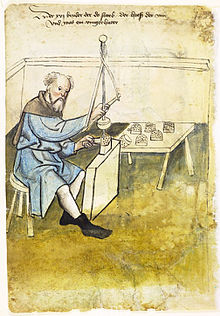Thimble
Thimbles were called manufacturers of thimbles (thimble makers ). They handcrafted thimbles from brass or sheet iron strips with the help of steel punches and punches.
In 1373 there were real thimble makers in Nuremberg and around 1500 the first masterpieces in thimble craft in Nuremberg. Since 1537 they have been subject to a professional code of conduct there, making their craft a protected profession. It developed from the craft of the "brass burner". They made the coveted sheet metal from copper and zinc ore. In Nuremberg the production of ductile brass succeeded for the first time, a prerequisite for labor-saving deep drawing . Until 1530, each thimble had to be cast individually. The Nuremberg thimbles were among the export items traded around the world and millions of them were produced.
Around 1568, Jost Ammann published a poem by Hans Sachs on the production of thimbles:
I make thimble out of brass,
sometimes artful, narrow and wide.
Tin white, they glow in the fire.
Ready for shoemakers and tailors,
because driven into iron luck.
For silk stickers and seamstresses, then
cut holes in it.
The craft I am a master.
literature
- Helmut Greif: The Nuremberg thimbles. To develop a medieval guild and the genealogy of their families. Trier 1989. ISBN 978-392203112-3
Individual evidence
- ↑ a b History of the thimble on fingerhutmuseum.de, accessed on June 25, 2016

